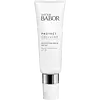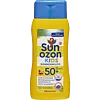What's inside
What's inside
 Key Ingredients
Key Ingredients

 Benefits
Benefits

 Concerns
Concerns

 Ingredients Side-by-side
Ingredients Side-by-side

Water
Skin ConditioningEthylhexyl Methoxycinnamate
UV AbsorberDiethylamino Hydroxybenzoyl Hexyl Benzoate
UV FilterEthylhexyl Triazone
UV AbsorberDibutyl Adipate
EmollientGlycerin
HumectantMethyl Methacrylate Crosspolymer
Phenylbenzimidazole Sulfonic Acid
UV AbsorberBis-Ethylhexyloxyphenol Methoxyphenyl Triazine
Skin ConditioningArginine
MaskingUndecane
EmollientLauryl Glucoside
CleansingPolyglyceryl-2 Dipolyhydroxystearate
Skin ConditioningTridecane
PerfumingAluminum Starch Octenylsuccinate
AbsorbentTocopheryl Acetate
AntioxidantDimethicone
EmollientPanthenol
Skin ConditioningPhenoxyethanol
PreservativeMaltodextrin
AbsorbentXanthan Gum
EmulsifyingButylene Glycol
HumectantMethylparaben
PreservativeEthylparaben
PreservativeDisodium EDTA
Propylene Glycol
HumectantPentylene Glycol
Skin ConditioningCassia Alata Leaf Extract
AstringentCitric Acid
BufferingCaesalpinia Spinosa Fruit Extract
Skin ProtectingCaprylic/Capric Triglyceride
MaskingSodium Carboxymethyl Beta-Glucan
CleansingTocopherol
AntioxidantAscorbyl Tetraisopalmitate
AntioxidantBiosaccharide Gum-4
Skin ConditioningHelianthus Annuus Sprout Extract
Skin ConditioningPantolactone
HumectantCarbomer
Emulsion StabilisingHelianthus Annuus Seed Oil
EmollientDna
Skin ConditioningWater, Ethylhexyl Methoxycinnamate, Diethylamino Hydroxybenzoyl Hexyl Benzoate, Ethylhexyl Triazone, Dibutyl Adipate, Glycerin, Methyl Methacrylate Crosspolymer, Phenylbenzimidazole Sulfonic Acid, Bis-Ethylhexyloxyphenol Methoxyphenyl Triazine, Arginine, Undecane, Lauryl Glucoside, Polyglyceryl-2 Dipolyhydroxystearate, Tridecane, Aluminum Starch Octenylsuccinate, Tocopheryl Acetate, Dimethicone, Panthenol, Phenoxyethanol, Maltodextrin, Xanthan Gum, Butylene Glycol, Methylparaben, Ethylparaben, Disodium EDTA, Propylene Glycol, Pentylene Glycol, Cassia Alata Leaf Extract, Citric Acid, Caesalpinia Spinosa Fruit Extract, Caprylic/Capric Triglyceride, Sodium Carboxymethyl Beta-Glucan, Tocopherol, Ascorbyl Tetraisopalmitate, Biosaccharide Gum-4, Helianthus Annuus Sprout Extract, Pantolactone, Carbomer, Helianthus Annuus Seed Oil, Dna
Water
Skin ConditioningC12-15 Alkyl Benzoate
AntimicrobialButyl Methoxydibenzoylmethane
UV AbsorberDicaprylyl Ether
EmollientGlycerin
HumectantEthylhexyl Salicylate
UV AbsorberEthylhexyl Triazone
UV AbsorberCetearyl Alcohol
EmollientGlyceryl Stearate
EmollientBis-Ethylhexyloxyphenol Methoxyphenyl Triazine
Skin ConditioningDiethylhexyl Butamido Triazone
UV AbsorberSodium Stearoyl Glutamate
CleansingButyrospermum Parkii Butter
Skin ConditioningPhenylbenzimidazole Sulfonic Acid
UV AbsorberCaprylyl Glycol
EmollientDecylene Glycol
Skin ConditioningTocopheryl Acetate
AntioxidantXanthan Gum
EmulsifyingSodium Hydroxide
BufferingEthylhexylglycerin
Skin ConditioningPiroctone Olamine
PreservativeTocopherol
AntioxidantWater, C12-15 Alkyl Benzoate, Butyl Methoxydibenzoylmethane, Dicaprylyl Ether, Glycerin, Ethylhexyl Salicylate, Ethylhexyl Triazone, Cetearyl Alcohol, Glyceryl Stearate, Bis-Ethylhexyloxyphenol Methoxyphenyl Triazine, Diethylhexyl Butamido Triazone, Sodium Stearoyl Glutamate, Butyrospermum Parkii Butter, Phenylbenzimidazole Sulfonic Acid, Caprylyl Glycol, Decylene Glycol, Tocopheryl Acetate, Xanthan Gum, Sodium Hydroxide, Ethylhexylglycerin, Piroctone Olamine, Tocopherol
Ingredients Explained
These ingredients are found in both products.
Ingredients higher up in an ingredient list are typically present in a larger amount.
You might know this ingredient as Tinosorb S or Bemotrizinol. It is a UV filter that covers both UVA and UVB rays.
This ingredient has two peak UV absorption peaks ( 310 and 340 nm) and is able to absorb both UV-A and UV-B rays. This ingredient works by preventing UV rays from reaching and damaging your skin.
On top of that - it is highly photostable and helps prevent the photodegration of other sunscreen ingredients such as avobenzone.
Tinosorb S is allowed in the EU, Australia, and Asia. It is close to being approved by the FDA and we'll hopefully get this ingredient in the U.S. by late 2025.
Fun fact: Tinosorb S is the most effective UV absorber at maximum concentration (measured by SPF) permitted in the EU.
This ingredient is oil-soluble, so your oil-cleansers will take this right off at night.
Learn more about Bis-Ethylhexyloxyphenol Methoxyphenyl TriazineEthylhexyl Triazone is a modern chemical sunscreen that protects from UV-B radiation.
It is the most effective of existing UV-B filters, as it provides the highest level of photo-stable absorption. It protects from the entire UV-B range (280 to 320nm), with it's highest level of protection at 314nm.
Ethylhexyl Triazone is oil soluble, oderless and colorless, which mean it is able to be incorporated into a variety of different formulations.
It is not currently available within the United States due to slow changing FDA regulations. Outside of the US, it is used in formulations at concentrations up to 5%.
Learn more about Ethylhexyl TriazoneGlycerin is already naturally found in your skin. It helps moisturize and protect your skin.
A study from 2016 found glycerin to be more effective as a humectant than AHAs and hyaluronic acid.
As a humectant, it helps the skin stay hydrated by pulling moisture to your skin. The low molecular weight of glycerin allows it to pull moisture into the deeper layers of your skin.
Hydrated skin improves your skin barrier; Your skin barrier helps protect against irritants and bacteria.
Glycerin has also been found to have antimicrobial and antiviral properties. Due to these properties, glycerin is often used in wound and burn treatments.
In cosmetics, glycerin is usually derived from plants such as soybean or palm. However, it can also be sourced from animals, such as tallow or animal fat.
This ingredient is organic, colorless, odorless, and non-toxic.
Glycerin is the name for this ingredient in American English. British English uses Glycerol/Glycerine.
Learn more about GlycerinThis ingredient is more commonly known as Ensulizole, a chemical sunscreen ingredient.
Ensulizole mainly protects UV-B (290-340 nm) but offers a little UV-A (320-400 nm) protection. It is often paired with less photo-stable sunscreen ingredients due to its photo-stability.
Due to it being water-soluble, Ensulizole helps give sunscreens a light and non-oily texture.
Ensulizole is approved worldwide:
Learn more about Phenylbenzimidazole Sulfonic AcidTocopherol (also known as Vitamin E) is a common antioxidant used to help protect the skin from free-radicals and strengthen the skin barrier. It's also fat soluble - this means our skin is great at absorbing it.
Vitamin E also helps keep your natural skin lipids healthy. Your lipid skin barrier naturally consists of lipids, ceramides, and fatty acids. Vitamin E offers extra protection for your skin’s lipid barrier, keeping your skin healthy and nourished.
Another benefit is a bit of UV protection. Vitamin E helps reduce the damage caused by UVB rays. (It should not replace your sunscreen). Combining it with Vitamin C can decrease sunburned cells and hyperpigmentation after UV exposure.
You might have noticed Vitamin E + C often paired together. This is because it is great at stabilizing Vitamin C. Using the two together helps increase the effectiveness of both ingredients.
There are often claims that Vitamin E can reduce/prevent scarring, but these claims haven't been confirmed by scientific research.
Learn more about TocopherolTocopheryl Acetate is AKA Vitamin E. It is an antioxidant and protects your skin from free radicals. Free radicals damage the skin by breaking down collagen.
One study found using Tocopheryl Acetate with Vitamin C decreased the number of sunburned cells.
Tocopheryl Acetate is commonly found in both skincare and dietary supplements.
Learn more about Tocopheryl AcetateWater. It's the most common cosmetic ingredient of all. You'll usually see it at the top of ingredient lists, meaning that it makes up the largest part of the product.
So why is it so popular? Water most often acts as a solvent - this means that it helps dissolve other ingredients into the formulation.
You'll also recognize water as that liquid we all need to stay alive. If you see this, drink a glass of water. Stay hydrated!
Learn more about WaterXanthan gum is used as a stabilizer and thickener within cosmetic products. It helps give products a sticky, thick feeling - preventing them from being too runny.
On the technical side of things, xanthan gum is a polysaccharide - a combination consisting of multiple sugar molecules bonded together.
Xanthan gum is a pretty common and great ingredient. It is a natural, non-toxic, non-irritating ingredient that is also commonly used in food products.
Learn more about Xanthan Gum